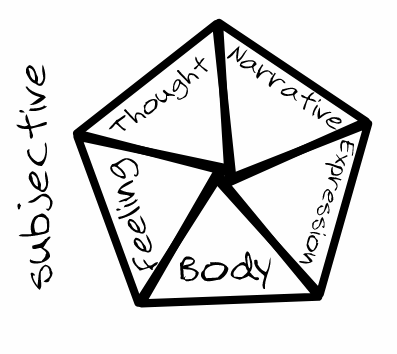Subjective
Subjective
Subjective
The subjective group aims to encapsulate some of the common areas we work in therapy. It is easy to confuse it with the identity group, but the main difference is that in these five, we tend to be ‘subject’ to them; therefore, they feel further away from our worries. In the identity group, those areas are part of our day-to-day worries and seem problematic by themselves, while the subjective ones are problematic only if someone points them out.
Please remember that these are broad areas or flavours, and any particular technique may belong to more than one.

🤸 Body:
Area of work that refers to the physical body in its different forms: as flesh (tendons, muscles), as experiential body, as sensations, as positions, as gestures, as body language, etc.
I am explicitly naming different ways of seeing the body as there are approaches that emphasise each of those areas. It is easier to group them as body practices, but as we explore we see there are many ways of addressing our body.
Some are Sensoriomotor therapy, somatic therapy, bioenergetics, vegetorerapy, etc.
💚 Feelings:
Area of our feelings, where we can recognise them, name them, learn about its processes and nuances. Even though belonging to all approaches, some focus more on feelings, specially the ones that are more phenomenological, like Person centred or Focusing. Some work directly with feelings and its body manifestations, like Alba Emoting.
There are many ways of working with feelings, from more body angles, from descriptions of experience, from giving them clearer names, from relational spaces, etc.
🧠 Thoughts:
Even though belonging clearly to Cognitive Behavioural, it is part of many approaches. Again there are many ways of seeing a thinking process. CBT would focus on the rationality of the premises and processes, while Lacanians would focus on the breaks and unconscious resonances of the words.
This area, in general, explores logic, induction, deduction and abduction, searches for healthy processes and to generate a more integrated ‘ego’ function.
📖 Narrative:
Narrative therapist work with the plot, with the characters, the timelines and the archetypes. They search for new narratives and alternative stories to unlock rigid views of ourselves. This way of working also is used by multiple therapist as they listen to their clients actively, even if not having a framework for it.
Having a notion of narrative help the active listening of any practitioner, and help us to be closer to our clients experience.
It is used by many approaches in different ways, by interpreting and creating a dynamic history (psychoanalysis), or by enacting in a group (drama therapy), by giving space and reflecting back, or by being attentive and resonating with life and its nuances.
🎨 Expression:
This one is tricky because it feels like it belongs to the other ones. After long thought I concluded it was a distinctive area of psychotherapy. Expression integrates the previous parts of the subjective group but can also be considered an independent skill. Expression is about being able to connect an inner process with a shape in the world. It is not just about narrating but feeling that the narration expresses what is felt. It is not about thinking but that the thoughts expresses the contents in their complexity and contradiction.
Some therapist and approaches put more emphasis in this area, like in Art Therapies, Gestalt or Drama therapy. In general artistic therapist, or more enactive therapist use expression as their focus, and the other components reside as secondary to expression. This is what makes it a distinctive flavour of our practice, because we can work the other parts without an emphasis on Expression or we can work from Expression multiple other areas.